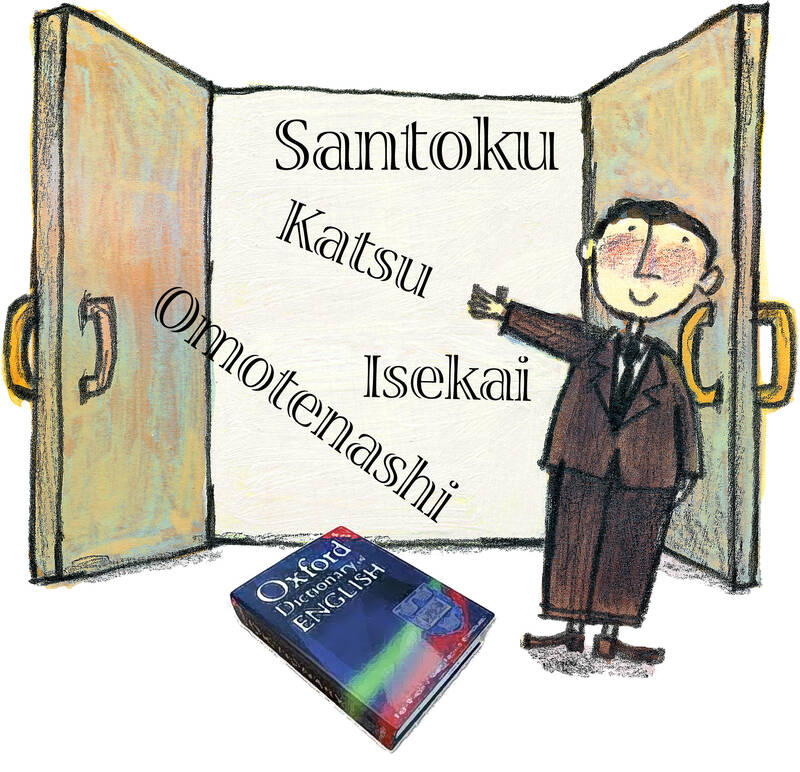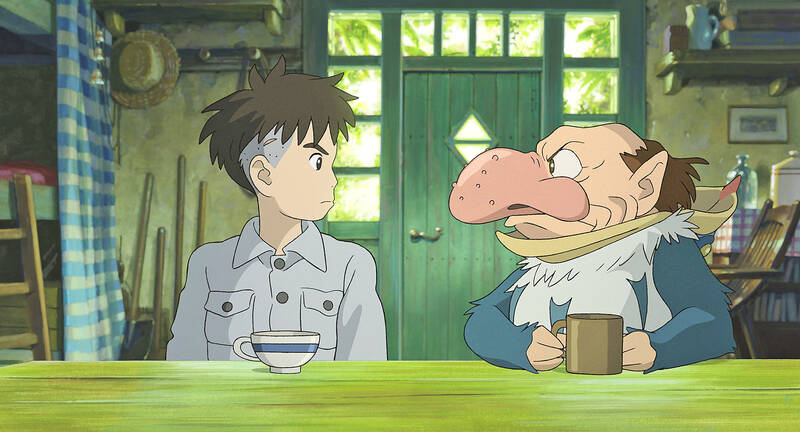Katsu, donburi and onigiri are among 23 Japanese words added to the Oxford English Dictionary (OED) in its latest update.
More than half of the borrowed words relate to food or cooking. Santoku, a knife with a short, flat blade that curves down at the tip, and okonomiyaki, a type of savory pancake, were both added. Okonomiyaki is derived from okonomi, meaning “what you like,” combined with yaki, meaning “to fry, to sear.”
Katsu — a piece of meat, seafood or vegetable, coated with flour, egg and panko breadcrumbs, deep-fried, and cut into strips — is considered a boomerang word, a case of reborrowing: katsu is the shortened form of katsuretsu, which is a borrowing into Japanese of the English word “cutlet.”

GRAPHIC: TT
Donburi, a Japanese dish consisting of rice topped with other ingredients, is also used to describe the bowl in which this dish is served. The culinary use is likely related to the Japanese adverb donburi, meaning “with a splash,” which “could be an allusion to the sound of ingredients being dropped into a bowl,” said Danica Salazar, executive editor of OED’s World Englishes.
Omotenashi, which describes good hospitality, characterized by “thoughtfulness, close attention to detail and the anticipation of a guest’s needs” was also added to the dictionary.
CREATIVE LANGUAGE

Photo: AP
A number of terms related to art also feature in the update. “For centuries, artists from around the world have taken inspiration from Japanese art, and this can be seen in the number of words belonging to the domain of arts and crafts that English has borrowed from Japanese,” said Salazar.
Kintsugi, the Japanese art of repairing broken pottery by joining pieces back together and filling cracks with lacquer dusted with powdered gold, silver or platinum, highlighting the flaws in the mended object, was added. “The word subsequently developed an additional sense indicating an aesthetic or worldview characterized by embracing imperfection and treating healing as an essential part of human experience,” said Salazar.
Isekai, a Japanese genre of fantasy fiction involving a character being transported to or reincarnated in a different, strange, or unfamiliar world, also made the OED. A recent example of the genre is Hayao Miyazaki’s Studio Ghibli film The Boy and the Heron, in which 12-year-old Mahito discovers an abandoned tower, a gateway to a fantastical world.
OED editors worked with researchers from the Tokyo University of Foreign Studies on the new batch of Japanese words. Non-Japanese words added in this quarter’s update include Bible-bashing, ultra-processed and bibliophilia.

Most heroes are remembered for the battles they fought. Taiwan’s Black Bat Squadron is remembered for flying into Chinese airspace 838 times between 1953 and 1967, and for the 148 men whose sacrifice bought the intelligence that kept Taiwan secure. Two-thirds of the squadron died carrying out missions most people wouldn’t learn about for another 40 years. The squadron lost 15 aircraft and 148 crew members over those 14 years, making it the deadliest unit in Taiwan’s military history by casualty rate. They flew at night, often at low altitudes, straight into some of the most heavily defended airspace in Asia.

Many people in Taiwan first learned about universal basic income (UBI) — the idea that the government should provide regular, no-strings-attached payments to each citizen — in 2019. While seeking the Democratic nomination for the 2020 US presidential election, Andrew Yang, a politician of Taiwanese descent, said that, if elected, he’d institute a UBI of US$1,000 per month to “get the economic boot off of people’s throats, allowing them to lift their heads up, breathe, and get excited for the future.” His campaign petered out, but the concept of UBI hasn’t gone away. Throughout the industrialized world, there are fears that

Like much in the world today, theater has experienced major disruptions over the six years since COVID-19. The pandemic, the war in Ukraine and social media have created a new normal of geopolitical and information uncertainty, and the performing arts are not immune to these effects. “Ten years ago people wanted to come to the theater to engage with important issues, but now the Internet allows them to engage with those issues powerfully and immediately,” said Faith Tan, programming director of the Esplanade in Singapore, speaking last week in Japan. “One reaction to unpredictability has been a renewed emphasis on

Taiwan’s democracy is at risk. Be very alarmed. This is not a drill. The current constitutional crisis progressed slowly, then suddenly. Political tensions, partisan hostility and emotions are all running high right when cool heads and calm negotiation are most needed. Oxford defines brinkmanship as: “The art or practice of pursuing a dangerous policy to the limits of safety before stopping, especially in politics.” It says the term comes from a quote from a 1956 Cold War interview with then-American Secretary of State John Foster Dulles, when he said: ‘The ability to get to the verge without getting into the war is